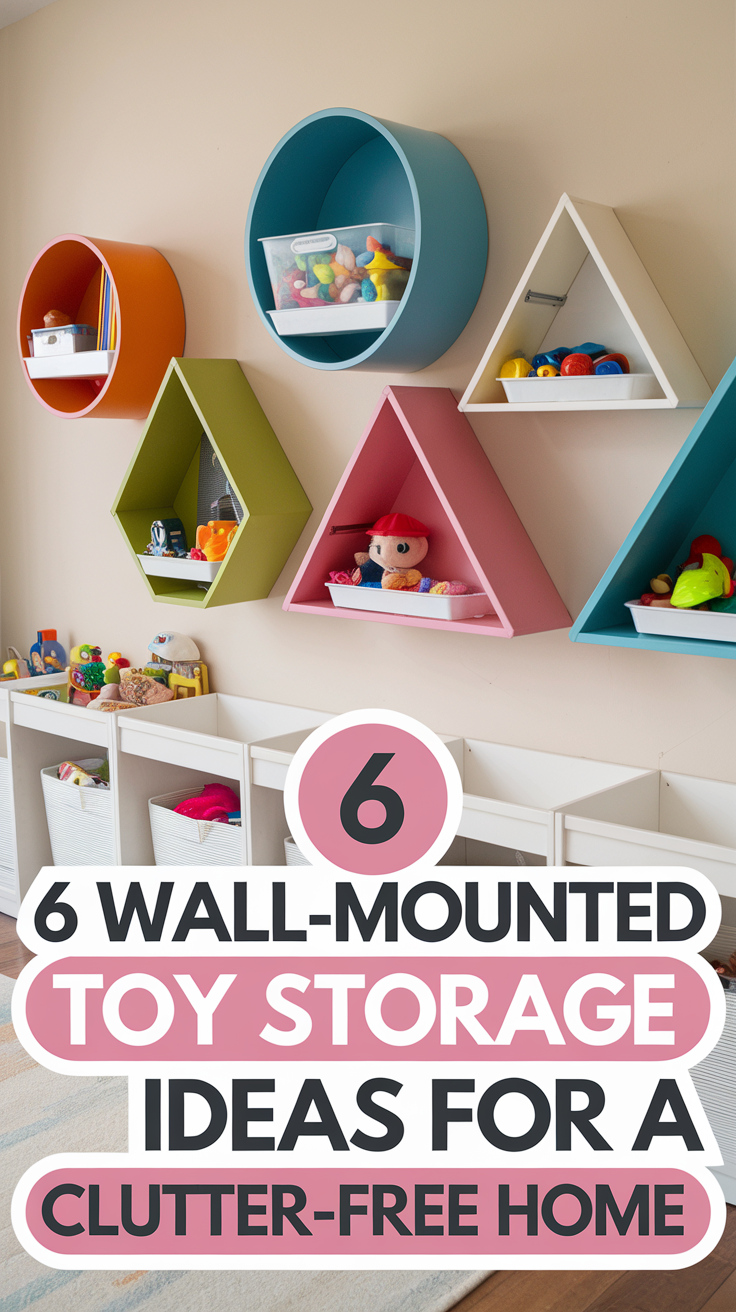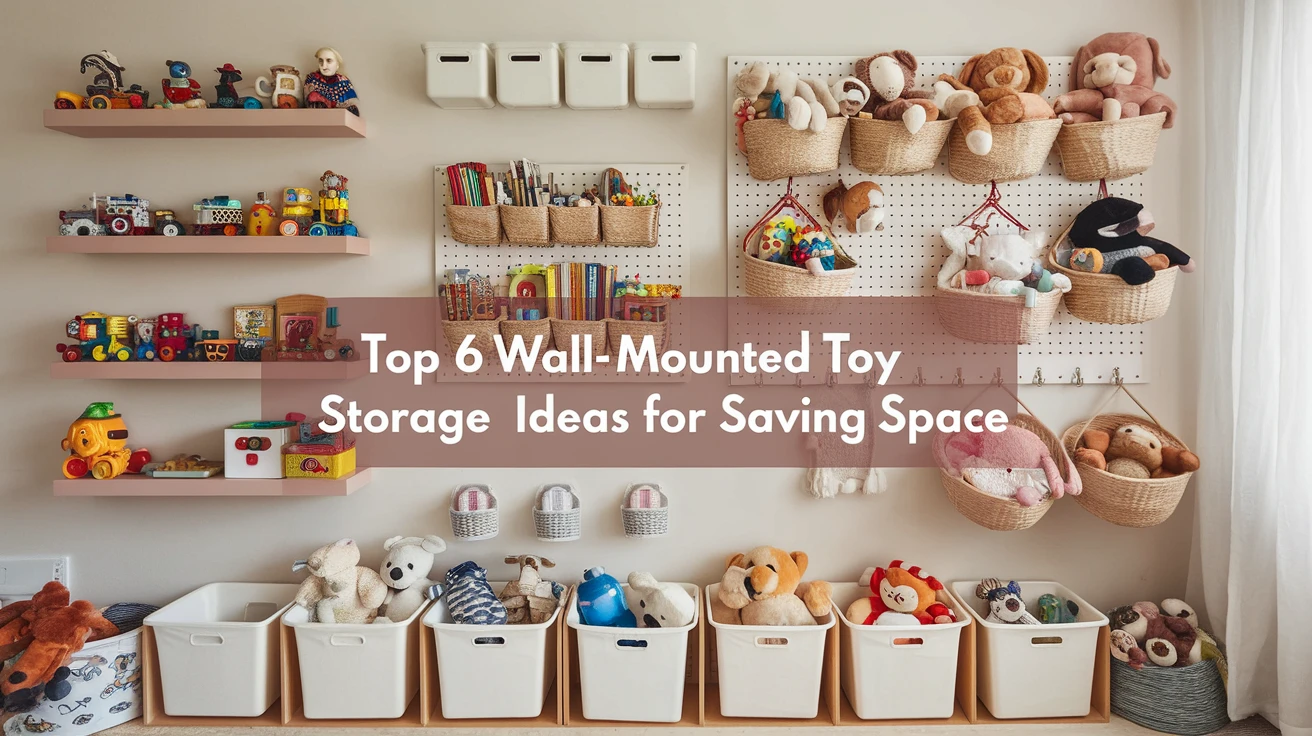
Introduction
If you’re constantly stepping on LEGO pieces or tripping over stuffed animals, it’s probably time to reconsider your toy storage strategy. Wall mounted toy storage has become the go-to solution for parents everywhere who are tired of the daily toy tornado. Not only does it free up valuable floor space, but it also teaches kids organizational skills and makes cleanup time so much easier. I’ve been there—drowning in a sea of toys with nowhere to put them—until I discovered the magic of vertical storage. In this article, I’ll share my top 6 wall-mounted storage ideas that have saved my sanity and my living space. Trust me, your feet (and your sanity) will thank you!
1. Floating Shelves with Bins
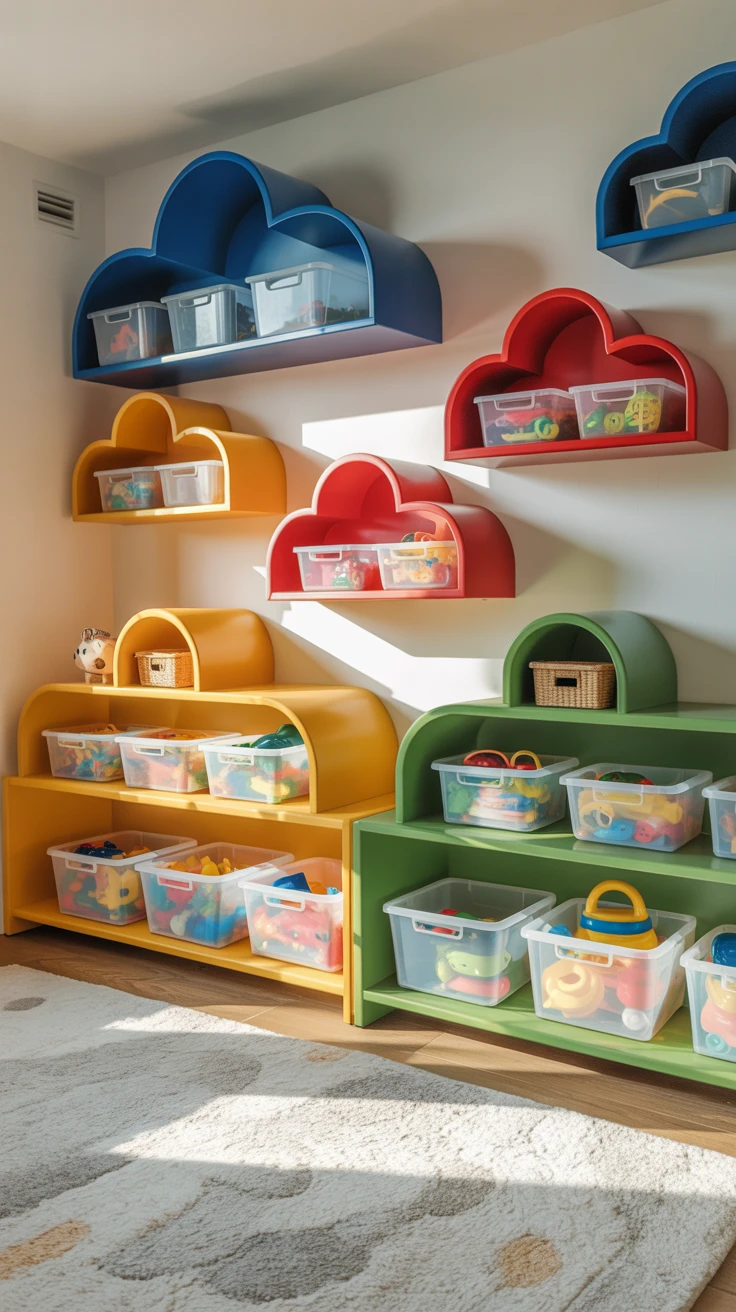
Floating shelves are perhaps the most versatile wall mounted toy storage option available. They blend seamlessly with any decor while providing substantial storage space for toys of all sizes. I installed these in my son’s room last year, and they’ve been absolute game-changers!
The beauty of floating shelves lies in their customization potential. You can arrange them in countless configurations—horizontally aligned, staggered for visual interest, or even in fun shapes like mountains or clouds for a children’s room. Pair them with colorful bins or baskets that slide right onto the shelves, and you’ve got an organization system that’s both functional and stylish.
- Clear plastic bins work wonderfully for frequently used toys as kids can see what’s inside
- Fabric bins in coordinating colors create a cohesive look while hiding visual clutter
- Labeled bins make cleanup time more straightforward for younger children
- Shallow bins are perfect for art supplies and small toys, while deeper ones accommodate larger items
Pro Tip: Install shelves at different heights to grow with your child. Lower shelves should house everyday favorites, while higher ones can store items that require adult supervision or seasonal toys in rotation.
2. Pegboard Systems
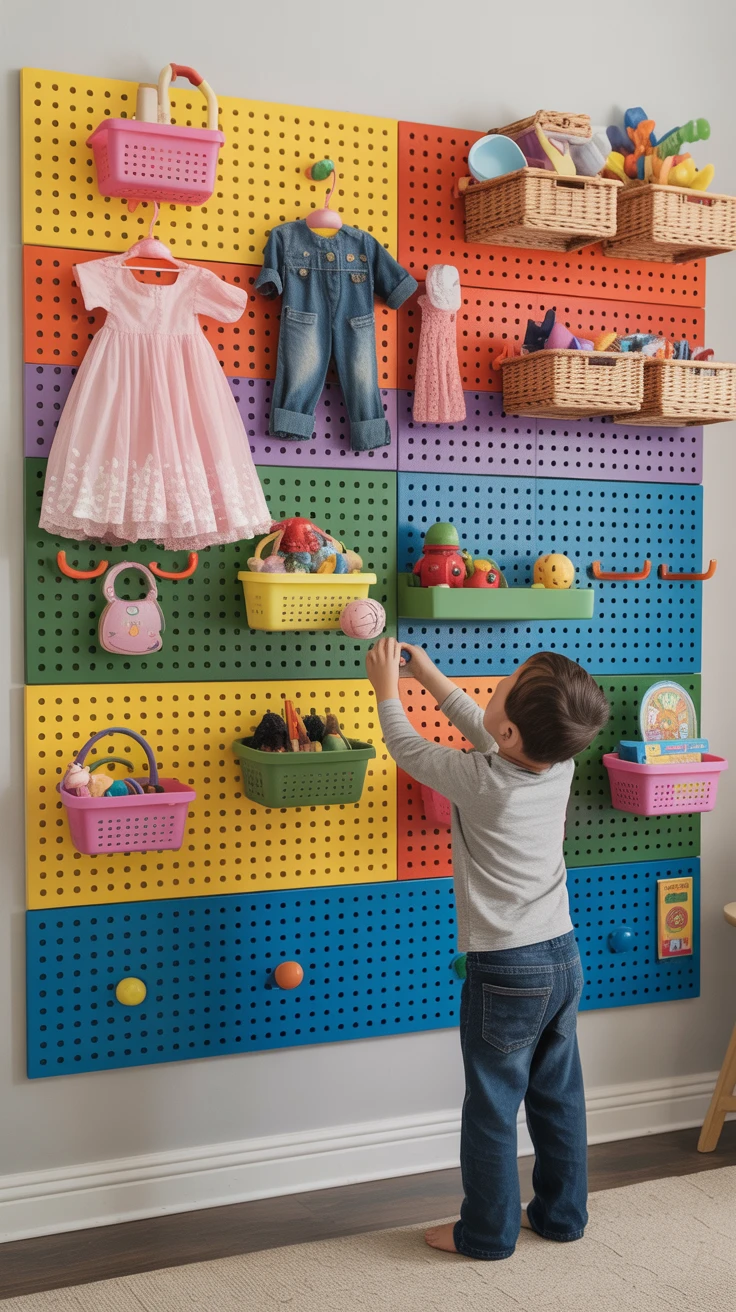
Remember those pegboards in your grandpa’s garage? They’ve had quite the makeover and are now one of the most adaptable wall mounted toy storage solutions available. A pegboard system provides endless configuration options that can evolve as your child’s toy collection changes.
What makes pegboards so brilliant is their adaptability. With a variety of hooks, baskets, shelves, and containers designed specifically for pegboard systems, you can create a custom storage wall that perfectly fits your needs. I’ve used pegboards in my craft room for years and recently installed one in my daughter’s playroom—it’s been absolutely revolutionary!
- Use hooks for hanging dress-up clothes, costume jewelry, or jump ropes
- Attach small baskets for building blocks, action figures, or doll accessories
- Add pegboard shelves for displaying special collections or favorite stuffed animals
- Install cups or containers for art supplies like markers, crayons, and paintbrushes
The best part? When your storage needs change, you can simply rearrange the components without putting new holes in your walls. It’s the ultimate flexible storage solution.
Pro Tip: Paint the pegboard in a fun color or pattern to make it a design feature rather than just a storage solution. Some parents even let their kids help design the layout, increasing the likelihood they’ll actually use it!
3. Wall Pocket Organizers
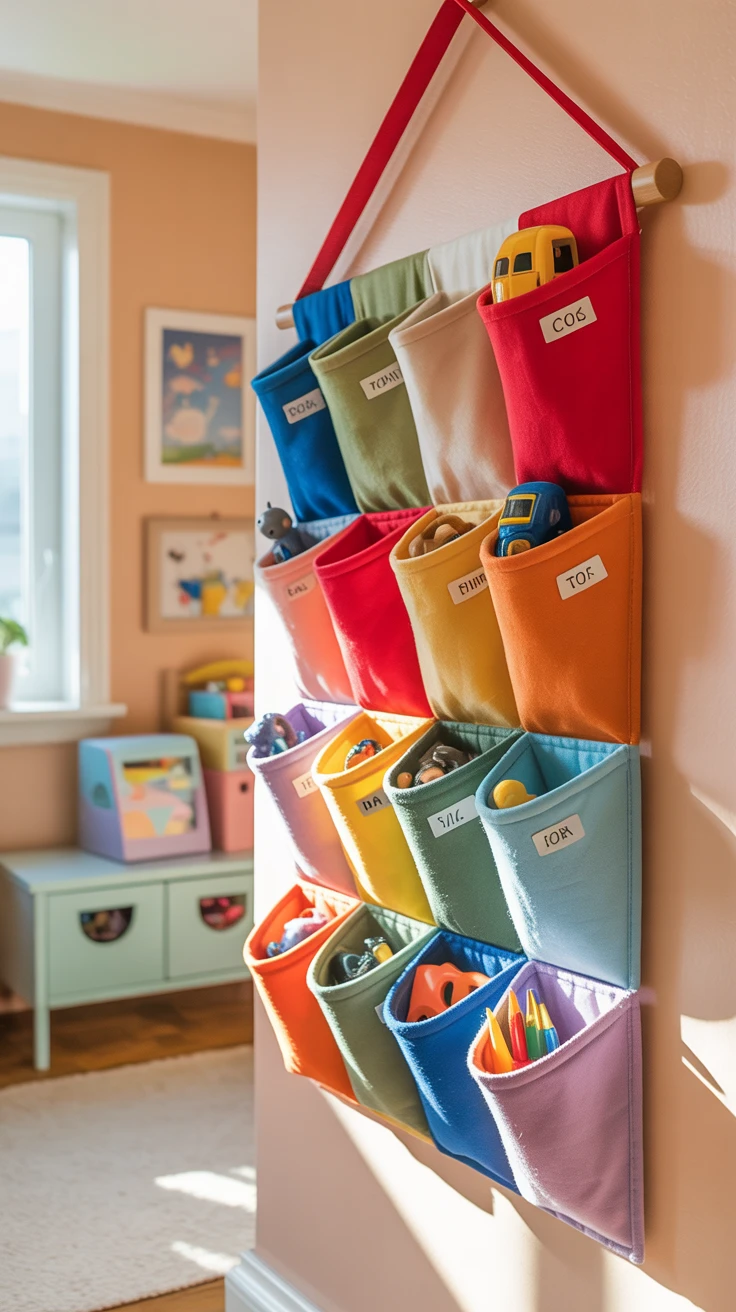
If you’re looking for a wall mounted toy storage option that’s affordable, easy to install, and surprisingly spacious, wall pocket organizers deserve your attention. These fabric organizers—similar to over-the-door shoe organizers but designed for wall mounting—feature multiple pockets of various sizes perfect for containing small to medium-sized toys.
I first discovered these when searching for a solution for my son’s ever-growing car collection. Now, instead of cars scattered across every surface, they each have their own little “parking space” in the wall organizer. It’s been absolutely brilliant for categorizing collections!
- Perfect for small collectibles like cars, figurines, or trading cards
- Great for art supplies, with each type getting its own designated pocket
- Ideal for stuffed animals, especially the smaller ones that tend to get lost
- Excellent for bath toys—hang near the tub for drip-dry storage
Many wall pocket organizers come in washable fabrics, making them practical for homes with young children. You can find them in various colors and patterns to complement your decor, or even in clear plastic if you prefer visibility.
Pro Tip: Use a label maker or fabric markers to label each pocket according to what belongs inside. This visual cue helps even non-readers know exactly where things should go during cleanup time.
4. Mesh or Net Toy Hammocks
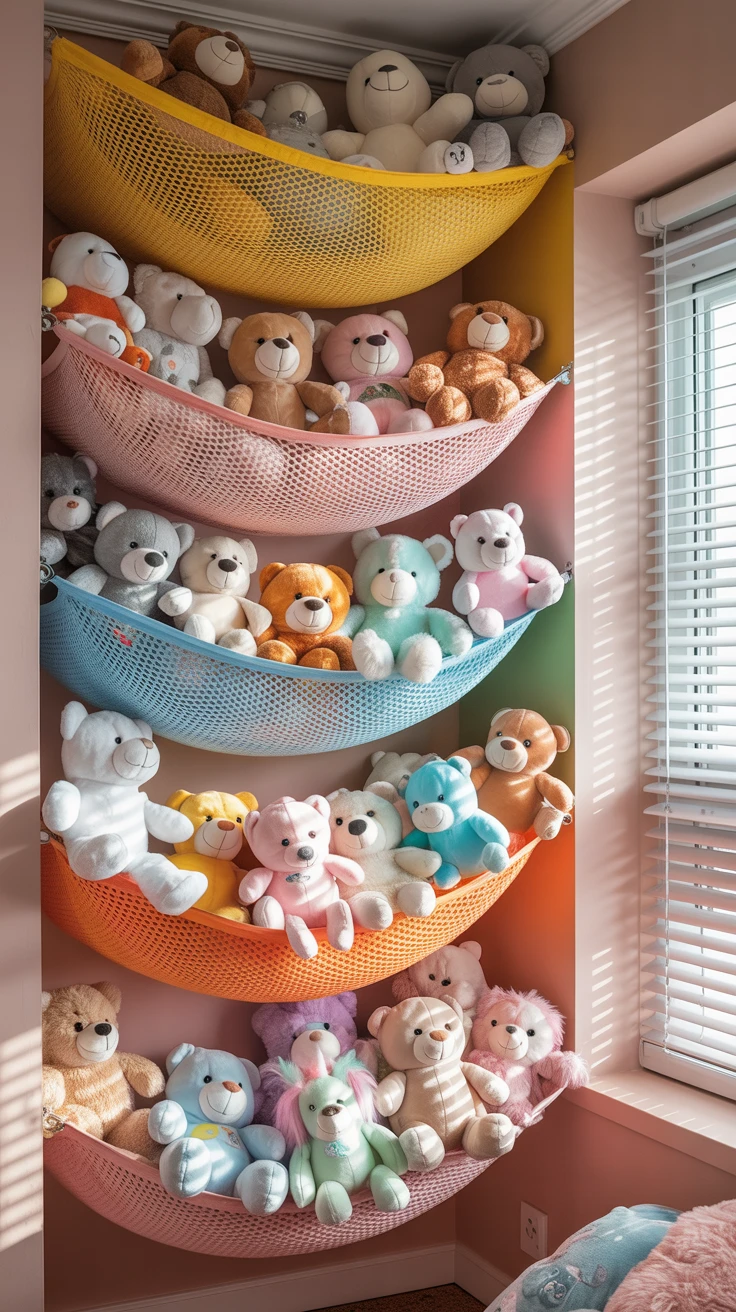
For the overflowing stuffed animal collection that seems to multiply overnight, mesh or net toy hammocks offer the perfect wall mounted toy storage solution. These hammocks hang in corners or along walls, utilizing often-overlooked space while keeping soft toys visible, accessible, and dust-free.
When my daughter’s stuffed animal family grew to the point of taking over her bed (leaving her with about 12 inches of sleeping space), I installed a couple of these hammocks. Now her furry friends have their own “apartments” overhead, and she can actually use her bed for, you know, sleeping!
- Stretchy mesh expands to accommodate surprisingly large collections
- Corner installations maximize otherwise unused space
- Toys remain visible, preventing the “out of sight, out of mind” syndrome
- Easy access allows kids to get toys themselves without climbing furniture
Beyond stuffed animals, these nets can store balls, lightweight sports equipment, or even seasonal items like beach toys during winter months.
Pro Tip: Install multiple hammocks at different heights to create a “stuffed animal apartment building.” This not only looks adorable but also encourages kids to categorize their collections (bears on one level, unicorns on another).
5. Magnetic Wall Strips
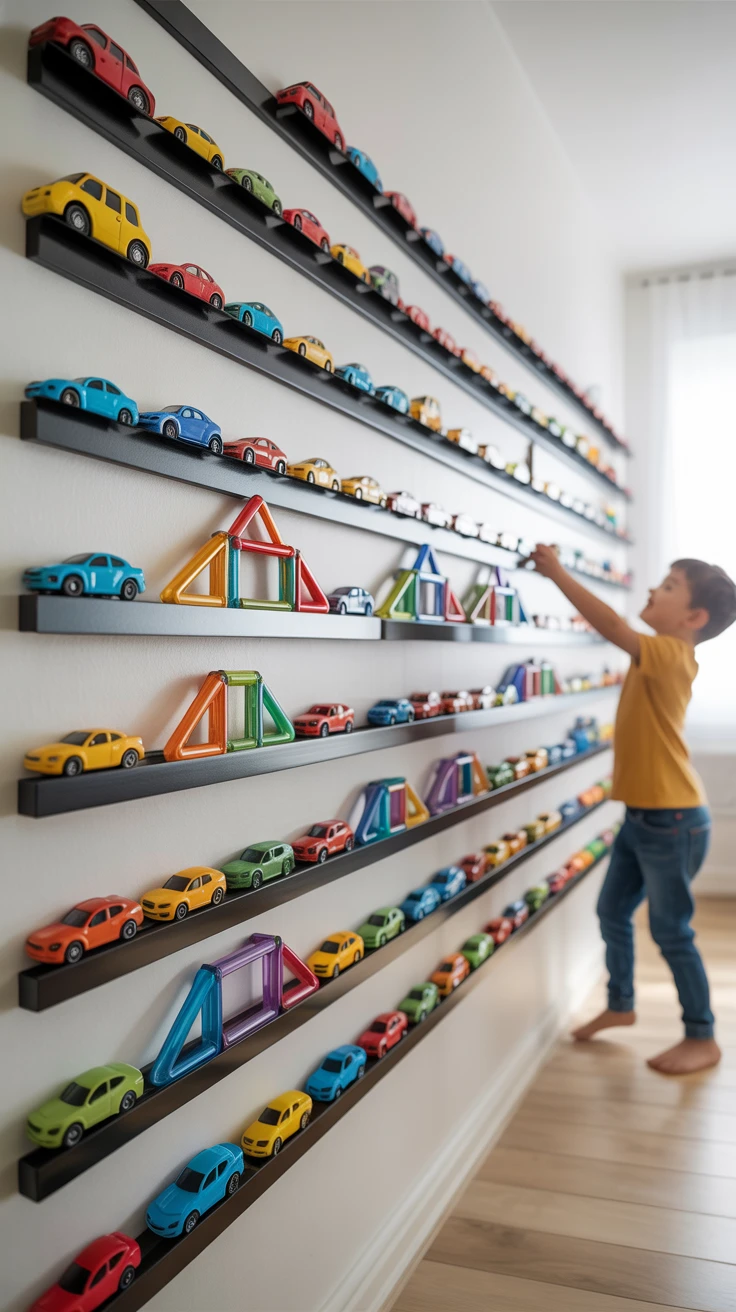
For toys with metal components, magnetic wall strips offer an innovative wall mounted toy storage solution that’s both practical and visually striking. Originally designed for kitchen knives, these powerful magnetic strips can be repurposed to hold everything from toy cars with metal bottoms to magnetic building sets.
I installed a magnetic strip in our playroom last year, and it’s become the go-to display for my son’s die-cast car collection. What I love most is how it transforms the toys into a kind of moving art installation—he’s constantly rearranging them by color, size, or type.
- Perfect for metal cars, trucks, and trains
- Ideal for magnetic building sets and components
- Great for small metal puzzles or brain teasers
- Can even hold some action figures with metal parts
Beyond the obvious organizational benefits, magnetic strips encourage creative play as kids can easily grab vehicles for impromptu races or building adventures without digging through bins.
Pro Tip: Install magnetic strips at child height along a wall to create a “road” or “parking lot” where toy cars can be displayed. You can even paint a simple road design on the wall behind the strips for added visual appeal.
6. Hanging Basket Systems
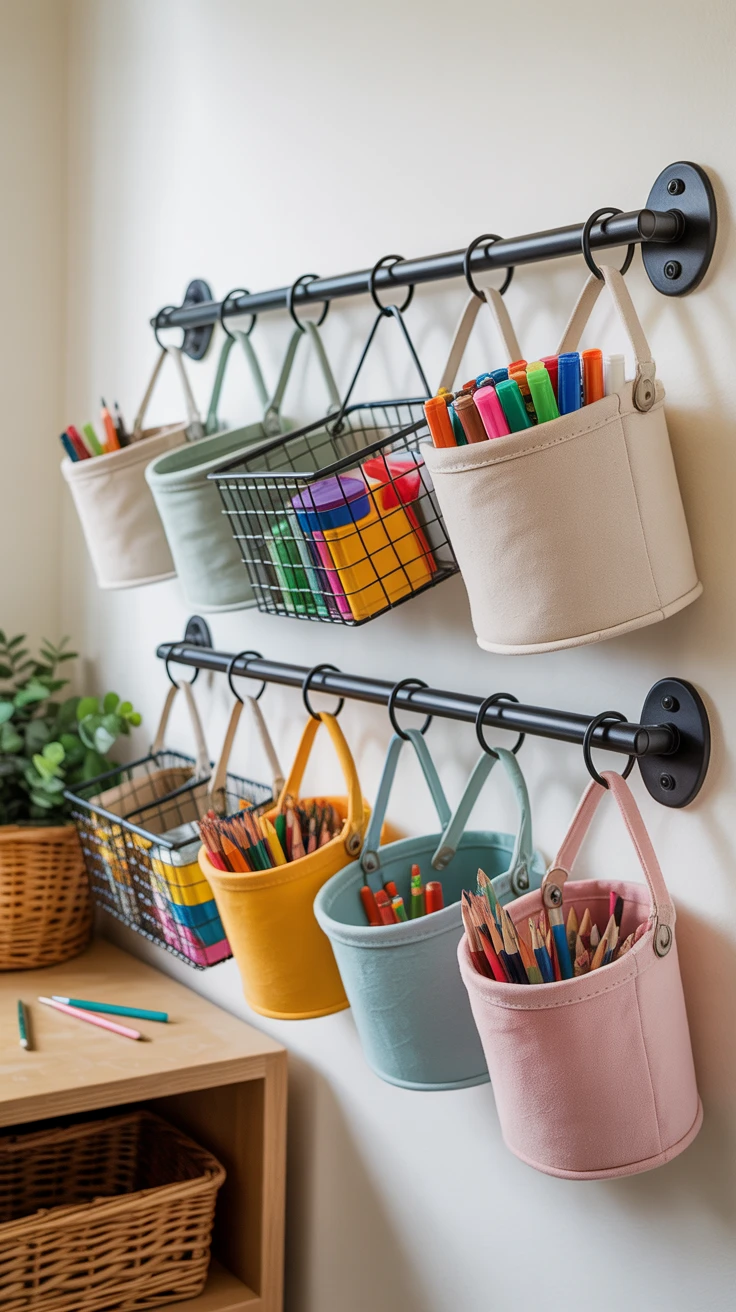
For a wall mounted toy storage solution with rustic charm and serious functionality, hanging basket systems deserve consideration. These versatile systems typically feature multiple baskets or buckets suspended from a wall-mounted rail, rod, or board.
After trying countless storage solutions for our art supplies, I finally installed a hanging basket system near our craft table. Now, instead of rummaging through drawers or boxes, the kids can see exactly what’s available—markers in one basket, colored pencils in another, paper in a third. It’s transformed our creative sessions from chaotic to (somewhat) controlled!
- Wire baskets offer visibility while containing items
- Canvas buckets provide a softer look and can be color-coded
- Metal pails add industrial charm and durability
- Plastic containers offer waterproof storage for messy items
The beauty of hanging basket systems lies in their flexibility—you can add, remove, or rearrange baskets as needs change, and many systems allow you to adjust the height of individual containers.
Pro Tip: Install a hanging basket system low enough for children to access independently, but with enough clearance underneath to place a small table or play mat. This creates a self-contained activity station where toys can be used and then returned to their proper homes.
Key Takeaways
- Wall mounted toy storage maximizes floor space while keeping toys organized and accessible
- Consider your child’s height and abilities when installing any wall storage system
- Choose solutions that can grow and adapt as your child’s toy collection changes
- Involve kids in the organization process to increase the likelihood they’ll maintain the system
- Combine different wall storage methods for a comprehensive solution that addresses various toy types
Conclusion
Implementing effective wall mounted toy storage solutions has been nothing short of transformative in my home, and I’m confident it can be in yours too. By utilizing vertical space that would otherwise go unused, you’re not just creating a more organized environment—you’re fostering independence, teaching organizational skills, and reclaiming your living areas from toy takeover. Whether you opt for floating shelves with colorful bins, an adaptable pegboard system, or any of the other solutions we’ve explored, the key is finding what works for your specific space, toys, and family dynamics. Remember that the best storage system is one that’s actually used, so involve your children in the process and make organization feel like part of the play experience rather than a chore. With these wall-mounted solutions, you’ll spend less time picking up toys and more time enjoying the space—and the little ones—you created them for.
Frequently Asked Questions
-
How do I install wall-mounted toy storage without damaging my walls?
For lighter storage options like pocket organizers or mesh hammocks, consider using adhesive hooks or strips designed for wall use. For heavier systems like floating shelves or pegboards, you’ll need to locate wall studs using a stud finder and secure the units with appropriate screws. If you’re renting, consider free-standing options that lean against walls or command strips rated for the weight of your storage system. Always check weight limits and follow manufacturer instructions.
-
What’s the best wall-mounted storage solution for small toys?
For tiny toys like LEGO pieces, small cars, or figurines, wall-mounted storage with containment is key. Floating shelves with bins, pegboards with attached containers, or pocket organizers work exceptionally well. Clear containers help children see what’s inside without dumping everything out. Magnetic strips are perfect for small metal toys, while labeled bins on shelves help maintain organization by category.
-
How high should I mount toy storage on walls for children to reach?
The ideal height depends on your child’s age and height. For toddlers and preschoolers, keep frequently used toys between 24-36 inches from the floor. For elementary-aged children, 36-48 inches is generally accessible. Consider creating a tiered system: everyday toys at the bottom, occasionally used items in the middle, and rarely used or parent-supervised toys at the top. Remember that children grow quickly, so building in some flexibility is wise.
-
Can wall-mounted toy storage work in a rental property?
Absolutely! Many wall-mounted storage solutions can be adapted for rental properties. Consider command hooks or strips for lighter options like pocket organizers or mesh hammocks. Tension rod systems can work for hanging baskets in some spaces. Freestanding options that lean against walls provide vertical storage without permanent installation. If you do need to make holes, keep track of anchors and hardware so you can patch properly when moving out.
-
How do I encourage my kids to use wall-mounted storage systems?
Involvement is key! Have children help design the system or choose containers. Use clear labeling with pictures for pre-readers. Make cleanup part of play routine—”the cars need to park in their garage before dinner.” Create games like cleanup races or “basketball” where toys are tossed into their containers. Most importantly, keep the system simple enough that children can maintain it independently. Praise their efforts and periodically review the system together to make sure it still meets their needs.
